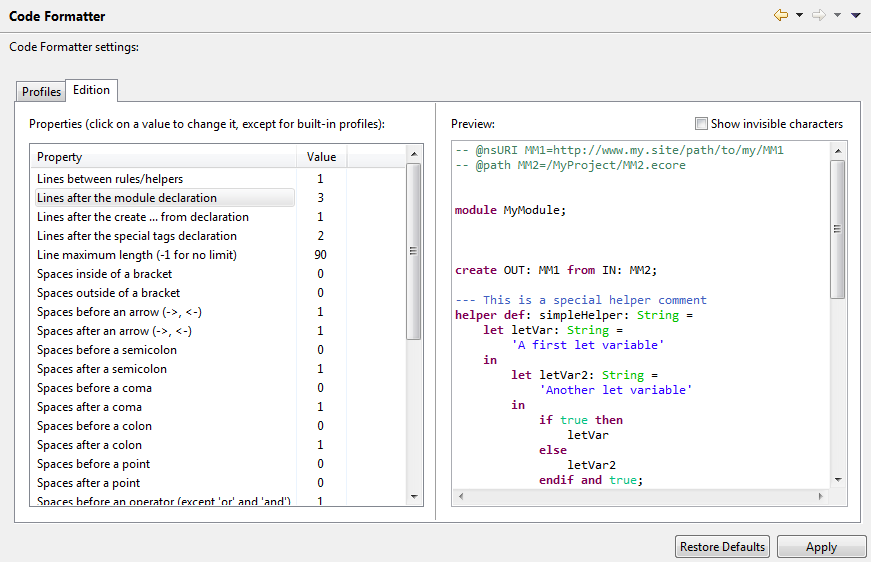

To open a tool window, click it in the tool window bar: Just like in Eclipse, in IntelliJ IDEA you also have tool windows. The IDE follows your context and brings up the relevant tools automatically. It means that you don't need to switch between different workspace layouts manually to perform different tasks. The second big surprise when you switch to IntelliJ IDEA is that it has no perspectives. The table below compares the terms in Eclipse and IntelliJ IDEA: If you still want to have several unrelated projects opened in one window, as a workaround you can configure them as modules. If you have several unrelated projects, you can open them in separate windows. While in Eclipse you normally have a set of projects that may depend on each other, in IntelliJ IDEA you have a single project that consists of a set of modules. This means that you can work with only one project at a time. The first thing you'll notice when launching IntelliJ IDEA is that it has no workspace concept. If you'd like to import your existing run configurations from Eclipse, consider using this third-party plugin.
Eclipse code formatter how to#
For more information on how to import a project, refer to Import a project from Eclipse.

If your project uses a build tool such as Maven or Gradle, we recommend selecting the associated build file pom.xml or adle when importing the project. When the Eclipse project is in the node, just click it to quickly open it in the IDE. This node will be available among the recent projects until you decide to remove it. IntelliJ IDEA automatically detects Eclipse projects located on your computer and places them in the dedicated node right on the Welcome screen. To do this, click Open on the Welcome Screen or select File | Open in the main menu. You can import either an Eclipse workspace or a single Eclipse project. Import an Eclipse project to IntelliJ IDEA This is the default test class.Switching from Eclipse to IntelliJ IDEA, especially if you've been using Eclipse for a long time, requires understanding some fundamental differences between the two IDEs, including their user interfaces, compilation methods, shortcuts, project configuration and other aspects. Let's figure out whether we can use state-of-the-art development tools to somehow simplify life.Ĭode formatting in IDEAAfter importing the project, press Ctrl+N and go to the AppTest class. When importing, set the " Use autoimport" checkbox. Now in the welcome window, run " Import Project" and import our new project. you see the code editor and project tree), close this project using File -> Close Project. If you see a window with an open project (i.e. Let's go to a new directory and run the following command there:Īfter that, start IntelliJ IDEA. Gradle has a great plugin: Build Init Plugin. It will let us get started quickly by creating a new project from a template. We'll use the Gradle build automation system. For example, in the vast expanses of the web, you can find the Google Java Style Guide and the Twitter Java Style Guide.įor this review, we need a test subject. Of course, as with ordinary language, conventions may change depending on where a language is used. What would it be like for someone who needs to check in a fix in just one method, but finds the whole file changed due to differences in spaces and tabs? Imagine the utter nightmare that version control would become if indentation was inconsistent, some people using tabs and other people using spaces. The rules for Java code are given in the document Code Conventions for the Java Programming Language.Ĭoding conventions can also regulate smaller details, such as indentation. And in Java, starting a method's name with a capital letter is a gross violation of coding conventions. For example, in polite society, wRiTiNg LiKe ThIs would be considered bad manners.

As with any language, some formatting conventions have been adopted in programming. But you too should understand it as you learn about the Java language. And this resource showed you code that the computer understands. When you started learning a programming language, you looked at books or some educational resource like CodeGym. But you can't have a personal conversation with a computer. The only difference is that it is a special language whose main purpose is to facilitate communication with a computer in order to explain to the computer what we want it to do. A programming language is very similar to a spoken language.


 0 kommentar(er)
0 kommentar(er)
